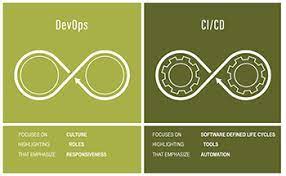The Role of DevOps in CI and CD
Practical Applications and Considerations in DevOps-Driven CI/CD

Introduction
In the fast-paced world of software development, the need for efficient and automated processes has never been more critical.During the development process, developers may need to perform linking of CI & CD and DevOps. This is where Continuous Integration (CI) and Continuous Deployment (CD) come into play, with DevOps as the driving force behind them. In this blog post, we will explore the essential role of DevOps in CI/CD, understanding how these practices work together to streamline software development and delivery.
Understanding CI/CD
Before delving into the role of DevOps, let’s first understand what CI/CD is all about.
- Continuous Integration (CI): CI is a development practice that involves developers frequently integrating their code into a shared repository. Each integration triggers an automated build and test process to detect and resolve integration issues early. This practice helps maintain code quality and collaboration among development teams.
- Continuous Deployment (CD): CD extends CI by automatically deploying code changes to production or staging environments after passing all tests. It aims to minimize manual intervention and accelerate the delivery of new features and bug fixes to end-users.
The DevOps Approach
DevOps is a set of cultural and technical practices that foster collaboration between development (Dev) and IT operations (Ops) teams. It emphasizes automation, communication, and continuous improvement. When it comes to CI/CD, DevOps plays a pivotal role in several ways:
1. Automation of Processes
DevOps encourages the automation of repetitive tasks throughout the software development lifecycle. CI/CD pipelines, which are central to these practices, automate various stages, such as code building, testing, and deployment. This automation reduces the risk of human error and ensures consistent and reliable software delivery.
2. Collaboration and Communication
Collaboration is a core principle of DevOps. Developers, testers, and operations teams work together to define and maintain CI/CD pipelines. This collaboration promotes a shared understanding of each stage of development, leading to smoother transitions and faster feedback loops.
3. Continuous Monitoring and Feedback
DevOps promotes the continuous monitoring of applications in production. Teams use various tools to collect data on application performance and user behavior. This data helps identify issues quickly, leading to faster problem resolution and continuous improvement of the software.
4. Security and Compliance
Security is an integral part of DevOps practices. Compliance requirements can also be automated and enforced, ensuring that the software meets regulatory standards.
5. Scalability and Resilience
DevOps practices prepare applications for scalability and resilience. By automating infrastructure provisioning and deployment, teams can easily scale resources up or down as needed. This agility is especially valuable in dynamic and rapidly changing environments.
Benefits of DevOps in CI/CD
The integration of DevOps into CI/CD processes yields several significant benefits:
- Faster Time-to-Market: DevOps-driven CI/CD accelerates the delivery of new features and bug fixes, allowing businesses to respond quickly to market demands.
- Improved Code Quality: Automated testing and continuous feedback result in higher code quality and fewer defects in production.
- Reduced Manual Work: Automation reduces manual intervention in deployment, minimizing the risk of human errors and freeing up valuable developer and operator time.
- Enhanced Collaboration: Collaboration between teams leads to better communication and understanding of each other’s roles and responsibilities.
- Increased Confidence: Automated testing and deployment processes instill confidence in developers and operators that changes will work as intended in production.
- Cost Savings: Efficient CI/CD practices reduce downtime and operational costs, making software development more cost-effective.
DevOps: The Glue Between CI and CD
In the software development world, DevOps bridges the gap between CI and CD, turning these two practices into a cohesive and powerful approach for delivering software. Here’s how DevOps influences each stage:
Continuous Integration (CI) and DevOps
CI is built upon the foundation of CI/CD
. It encourages developers to frequently integrate their code into a shared repository, triggering automated builds and tests. DevOps plays a crucial role in this phase by:
- Automating Build and Testing: DevOps teams create and manage automation scripts that build and test code automatically when changes are committed. This ensures that code quality is maintained throughout the development process.
- Maintaining a Culture of Collaboration: DevOps promotes a culture of collaboration between development and operations teams. This collaboration ensures that any integration issues are resolved promptly and that code is continuously integrated without bottlenecks.
- Streamlining Feedback Loops: DevOps encourages rapid feedback. When automated tests fail, feedback is sent to developers immediately, allowing them to address issues promptly. This feedback loop fosters a culture of continuous improvement.
Continuous Deployment (CD) and DevOps
While CI focuses on code integration and testing, CD takes the process further by automating deployment to various environments, including production. DevOps empowers CD by:
- Automation of Deployment Pipelines: DevOps engineers design and maintain CD pipelines, which automate the deployment process. These pipelines are orchestrated to deploy code to staging and production environments with minimal manual intervention.
- Continuous Monitoring and Feedback: DevOps extends the concept of continuous monitoring beyond the development phase. Once code is deployed, it continuously monitors the application in the production environment. If any issues arise, DevOps teams are alerted, and remediation is swift.
- Security and Compliance Integration: Security and compliance are paramount in CD. DevOps ensures that security checks and compliance tests are integrated into the deployment pipeline, preventing vulnerabilities from reaching production.
- Infrastructure as Code (IaC): DevOps practices often involve IaC, which allows infrastructure to be defined and provisioned through code. This streamlines the deployment of infrastructure along with the application code, enhancing reproducibility and consistency.
Practical Applications of DevOps in CI/CD
- Infrastructure as Code (IaC): In a DevOps-oriented CI/CD pipeline, infrastructure provisioning is treated as code. This means that infrastructure resources, such as servers, databases, and networks, are defined and managed through code scripts. This practice streamlines the setup of development, testing, and production environments, ensuring consistency and reducing the likelihood of configuration errors.
- Automated Testing: Automated testing is a cornerstone of both CI and CD. DevOps teams create and maintain suites of automated tests that run whenever code changes are made. These tests encompass unit tests, integration tests, and end-to-end tests. Any failures trigger alerts and halt the deployment process until the issues are resolved, ensuring that only thoroughly tested code reaches production.
- Containerization: Containers, such as Docker, have become an integral part of modern CI/CD pipelines. DevOps professionals use containerization to package applications and their dependencies, ensuring that software runs consistently across different environments. Container orchestration platforms like Kubernetes further enhance the scalability and resilience of applications.
- Continuous Monitoring: DevOps extends the concept of monitoring beyond production environments. In CI/CD, continuous monitoring tools provide insights into the performance of the entire pipeline, from code commits to production deployments. This visibility helps teams identify bottlenecks, optimize processes, and maintain the health of their CI/CD pipelines.
- Feedback-Driven Development: DevOps practices emphasize rapid feedback loops. Continuous integration feedback helps developers catch and fix issues early in the development process, reducing the cost and effort of addressing problems later. Continuous deployment feedback ensures that any issues arising in production are promptly addressed.
Conclusion
DevOps has become an essential driver in the successful implementation of Continuous Integration and Continuous Deployment. By fostering automation, collaboration, and continuous improvement, DevOps helps organizations deliver high-quality software faster and more reliably. The marriage of DevOps and CI/CD is not just a technological evolution; it’s a cultural shift that empowers teams to meet the ever-increasing demands of the digital age while ensuring the highest level of software quality and efficiency.
DevOps is the linchpin that holds together the principles of Continuous Integration and Continuous Deployment. By fostering a culture of collaboration, emphasizing automation, and implementing robust testing and monitoring, DevOps enables organizations to deliver high-quality software rapidly and efficiently. As technology continues to evolve, DevOps-driven CI/CD pipelines will remain a key strategy for staying competitive and meeting the demands of today’s fast-paced software development landscape.
if you want to explore more about career in Devops then,Click here.





